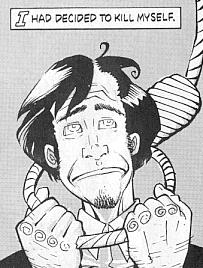Legend: Suicide attempt involving hanging, shooting, poisoning, and immolation goes wrong.
Examples:
[Smith, 1959] When I lectured to my students on multiple methods of suicide I generally finished up by relating the most outstanding case of all, a classic of its kind, which is, unfortunately, not susceptible to confirmation. I might say that it is not one of my cases. The story is that a highly pessimistic individual had determined to take his life, and wanted to make sure that there would be none of the [Morris, 1927] [A Tulsa youth] was in the Slough of Despond — the whole world had become utter darkness, life was not worth the living [Bryson, 1982] Intent on suicide, Frenchman Jacques Lefevre drove a stake into the ground on the top of a cliff overlooking the sea, then tied one end of a rope around the stake and the other around his neck. Being nothing if thorough, Lefevre then drank a bottle of poison, set his clothes on fire, lowered himself over the cliff, and tried to shoot himself in the head. Unfortunately he missed, the bullet cut the rope in two, dropping the hapless gentleman into the sea, where the salt water put out his flaming clothes and caused him to spew up the poison. A passing fisherman picked Lefevre up and delivered him to a nearby hospital, where at last the weary Frenchman got his wish - and died from the effects of exposure. |
Origins: This legend regained popularity in 1999 when it turned up as one of the nominees for the 1999 Darwin Awards. In that version,

the victim was said to be a Frenchman named Jacques Lefevrier.
There's no record of any Jacques Lefevrier (or Lefevre) meeting his maker in such a fashion, and the Darwin Award entry appears to have been lifted from a 1982 book of tall tales. This legend was also recounted in a 1944 London Daily Express article titled
A number of the earlier versions are simpler concoctions — they tell of a suicidal individual who tries to do himself in primarily by hanging but who plans to shoot himself in the head as a form of insurance. The opium he downs is for the purpose of making his passage out of this vale of tears and into the afterlife a painless one.
Fleshed-out versions have the unhappy man ingesting a poison rather than a painkiller, and also setting himself on fire. These additional details make for a more satisfyingly ludicrous mental picture of the attempt, but they also move the story from the realm of the remotely possible into the
world of fiction. Self-immolation (setting oneself on fire) is one of the least popular methods of self-termination. Those who resort to it are most often prompted by a desire to lodge a terminal protest with whoever wronged them in life, or to very publicly follow a loved one in death (e.g., the Hindu practice of sattee). It's a form of exit which plays to an audience, so if there's no audience present, it's unlikely to be chosen. The addition of immolation to this tale is clearly prompted by a desire to add one more death mode which can be foiled by the fall into the sea. (Another convoluted suicide attempt story can be found on our Ronald Opus page.)
The most recent example culminates with the fellow dying in an unplanned manner; though he's pulled from the water and receives medical care at a hospital, he ultimately succumbs to hypothermia. This gives the story a twist in that he gets what he wanted, just not the way he wanted it.
Earlier tellings see the hero live to change his mind (he swims to shore, after all). We're left with the impression he went on to live a long and happy life after Fate made it painfully clear his presence was not yet required in the afterlife.
Legends such as this confirm our belief in a higher power working quietly behind the scenes. No deaths are untimely, says this belief. If you're meant to go, you will. Likewise, if it's not your time, you're staying here no matter what you try.
Barbara "dead to the whirled" Mikkelson
Sightings: On the 1983 Robert Bryan and Marshall Dodge comedy album Bert & I Stem Inflation, there appears a piece called "Suicide" in which the tale of the failed suicide is recounted. The legend is also enacted in the British TV series Lovejoy in a episode called "Out to Lunch" (original air date
Last updated: 21 January 2007
 Sources:
Sources:
 Also told in:
Also told in:Flynn, Mike. The Best Book of Bizarre But True Stories Ever. London: Carlton, 1999. ISBN 1-85868-558-3 (p. 213).
The Big Book of Urban Legends.New York: Paradox Press, 1994. ISBN 1-56389-165-4 (pp. 98-99).
